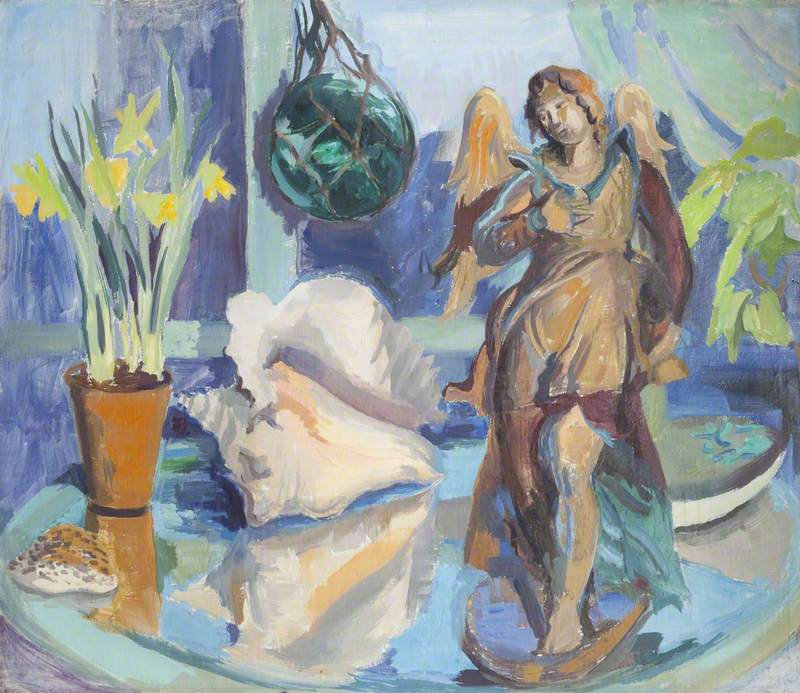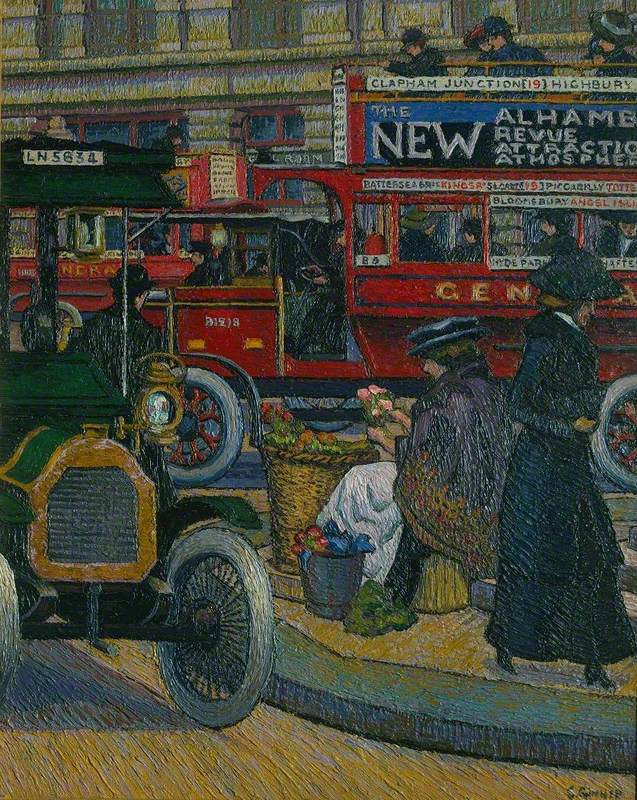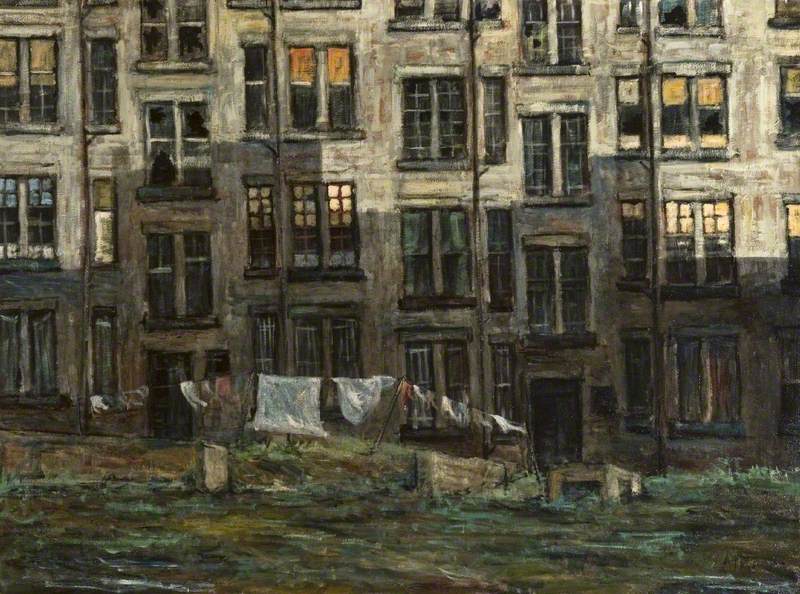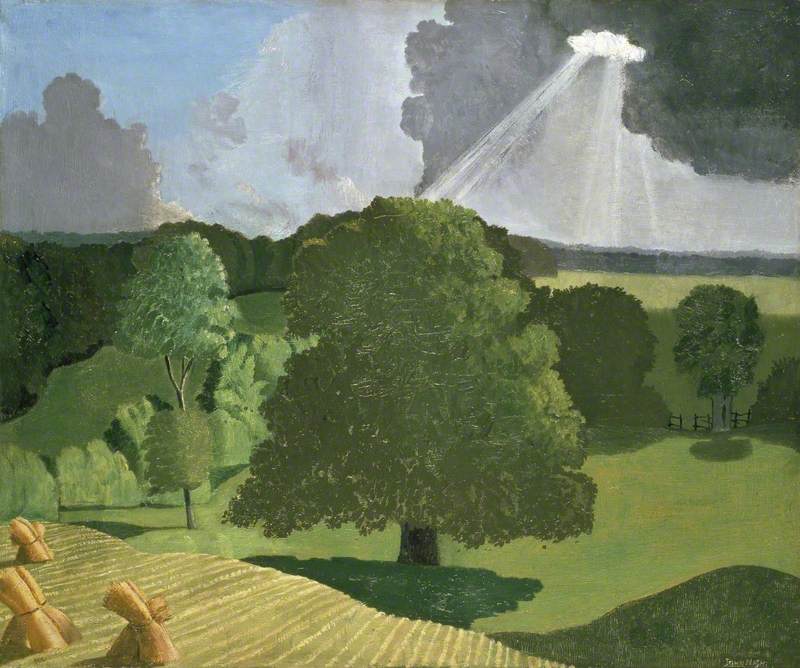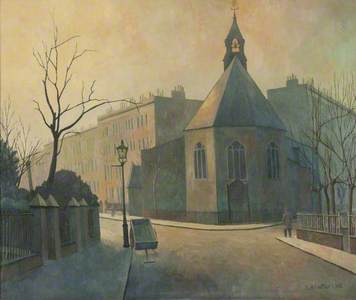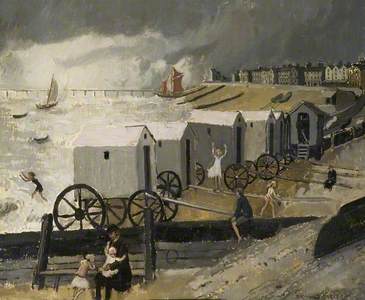The East London Group has gained much recognition in recent years, not least thanks to David Buckman's definitive 2012 book, From Bow to Biennale: Artists of the East London Group. That publication ignited a wave of exhibitions, including the first on the Group at the Nunnery Gallery, Bow, in 2014, which was curated by Alan Waltham – another tireless champion of these painters once hidden from view.

© the artist's estate. Image credit: Tower Hamlets Local History Library and Archives
The Jolly Butcher's, Cabbage Court, Brick Lane
Albert Edward Turpin (1900–1964)
Tower Hamlets Local History Library and ArchivesTen years later and Nunnery now hosts 'In the footsteps of the East London Group' (until 22nd December 2024 and co-curated by Waltham alongside Ferha Farooqui and Frank Creber), considering the impact of these historic works on contemporary urban painters. Seen today, these works from the interwar period document a now transformed London.

Image credit: Rob Harris, courtesy Bow Arts
Installation view, 'In the Footsteps of the East London Group', Nunnery Gallery, 2024
The Group itself emerged out of night classes held in Bethnal Green and Mile End during the 1920s and 1930s, attended by mostly working-class, part-time artists, who painted atmospheric streetscapes, dimly-lit interiors and canal views.
It's clear why the Group is often compared to the Camden Town Group, which aimed to depict the realities of urban life, and, in fact, Walter Sickert lectured at these classes and was a huge inspiration for the art produced. The Group went on to experience much success, exhibiting at Whitechapel Art Gallery and Tate.
The East London Group website lists 35 members, but who were the Group's main protagonists, and how should we understand their contribution to modern British art history?
John Cooper
Any discussion of the East London Group must start with John Cooper, who taught evening art classes at the Bethnal Green Men's Institute from 1925, and then at the Bow and Bromley Evening Institute. Teaching was a way for Cooper, a professional painter, to supplement his income; many of his students had received no formal training beyond school and worked in low-level jobs. The classes more broadly reveal the commitment to education and social equality in poorer areas such as east London during the interwar period.
Born in Bolton in 1894, Cooper grew up in Yorkshire and attended a number of art schools in the region before his education was cut short by the onset of the First World War. During the war, he served in the Royal Flying Corps and afterwards he resumed his artistic studies at the Slade School of Fine Art under the supervision of Henry Tonks.
Cooper encouraged his students to find beauty in a dingy, poverty-stricken part of London, although he rarely painted urban scenes himself (and, in fact, urban pictures make up only a small percentage of the Group's output, which also focused on landscapes and seascapes). Cooper knew Sickert from his student days and so he asked him to guest lecture, with Sickert echoing Cooper's belief that inspiration could be found nearby: 'There is no need to go to Bognor', he said. 'You can go into the Tube'.

© the artist's estate. Image credit: courtesy Alan Waltham and Bow Arts
Cumberland Market
1931 by Elwin Hawthorne (1905–1954)
Other influential Slade alumni who were enticed east by Cooper included William Coldstream and Phyllis Bray, both also exhibiting with the Group. Bray was married to Cooper for a brief period in the 1930s.
In December 1928, members of Cooper's Bow night classes exhibited at Whitechapel Art Gallery, collectively showing as the East London Art Club. Studio magazine described the show, which attracted the support of influential collectors Samuel Courtauld and Joseph Duveen, as 'little short of sensational'. Charles Aitken, director of the Tate, bought a number of works which were then displayed at Tate in 1929.

© the artist's estate. Image credit: courtesy Alan Waltham and Bow Arts
Bryant and Mays, Bow
c.1932–1933 by Grace Oscroft (1903–1970)
But Cooper's major success was arranging an exhibition at the Lefevre Gallery in Mayfair in 1929, going on to negotiate a contract lasting until 1936. As a result, the East London Group as they came to be known – made up of 33 members who showed roughly 730 paintings across eight exhibitions – exhibited alongside their British contemporaries including Paul Nash and Spencer Gore, as well as important modern French artists such as Cézanne, Picasso and Monet.
Following the end of the Lefevre contract and the untimely death of Cooper in 1943, the Group essentially disappeared, revealing the extent to which Cooper's managerial skills and art-world connections were the driving force behind the group's short-lived success.
Harold and Walter Steggles
The Steggles brothers are two of the Group's standout artists – Walter, alongside Elwin Hawthorne, would go on to participate in the Venice Biennale in 1936 in what may be seen as the high point of the Group's success.
Born in Ilford, Walter and Harold both left school at 14, working respectively in a shipping firm and solicitors' office. In May 1925, the brothers began art classes at Bethnal Green, later transferring to Bow under Cooper and becoming the youngest members of the East London Group. The brothers shared an exhibition at the Lefevre Gallery in 1938.

© Walter Steggles Bequest. Image credit: courtesy Alan Waltham and Bow Arts
Stratford
1938 by Walter Steggles (1908–1997)
Walter's painting Stratford from 1938, first shown in the joint exhibition with his brother, is now on display at the Nunnery and is indicative of the Group's output, a tranquil depiction of an urban scene. The river Lea and one of the nearby factory buildings are bathed in a golden light, the rich, buttery patch of sky at odds with this salubrious, industrial part of east London.
Both brothers favoured scenes devoid of human presence which lends their works an uneasy quality, clear in Harold's Blackwall from the early 1930s. Their focus is on shop fronts and backs of houses, canals, industrial infrastructure, wharfs, bridges and railway lines – the usually hidden spaces of ordinary life. Walter's early work The Railway Fence (1929), also on show at the Nunnery, highlights the electricity pylons running alongside the Great Eastern Railway Line, silhouetted against a vast smoggy sky.

© Walter Steggles Bequest. Image credit: courtesy Alan Waltham and Bow Arts
The Railway Fence
1929 by Walter Steggles (1908–1997)
Elwin Hawthorne
Elwin Hawthorne, the nephew of artist Henry Silk, was one of the Group's most prolific painters, especially of street scenes. An errand boy who left school at 14, Hawthorne worked as Sickert's studio assistant for three years, going on to have two solo shows at the Lefevre Gallery, the first alongside Vanessa Bell. In 1930, one Times critic claimed he was 'the most original member of the group', and that he was the English equivalent of the French painter Maurice Utrillo. In 1936, Hawthorne had a work included in the Venice Biennale.

© the artist's estate. Image credit: courtesy Alan Waltham and Bow Arts
Bow Road
1932 by Elwin Hawthorne (1905–1954)
Like many works by the Steggles brothers, Hawthorne's street scenes – which stretch into north London – are often empty and melancholic. The absence of people and his trademark spindly trees, clear in Bow Road (1929), lend Hawthorne's works both an eerie and surreal quality, and it's clear why he has been compared to Edward Hopper. He's also a master of light, suffusing these abandoned places in a yellowish, hazy glow.
In 1937 Hawthorne married Lilian Leahy, who was also a member of the Group, although she only submitted a couple of works to each of the eight Lefevre shows and has few surviving works from the period.
Henry Silk
Henry Silk was a basket weaver who was gassed in the First World War, leading him to live a somewhat reclusive lifestyle in the Bow home of his sister – the mother of Elwin Hawthorne. He took the evening classes with Cooper at both Bethnal Green and Bow and he showed with the Group at the Whitechapel exhibition through to the final Lefevre Gallery show in 1936. He also had a solo show of watercolours – his preferred medium – at Walter Bull & Sanders in 1931.
The impact of Sickert is clear in Silk's still lifes, which is what he is mostly known for – transforming mundane, everyday objects into artistic subjects worthy of attention.
Albert Turpin
Albert Turpin lived a much more eventful life than his profession as a window cleaner would suggest. Born in 1900 in a tenement in Bethnal Green, Turpin left school at 14 and served in the Marines during the First World War. Taking a job as a window cleaner after the war to earn some money, he joined the Labour Party in 1926, becoming a staunch anti-fascist – he was involved in the fight against Oswald Mosley's Blackshirts at the Battle of Cable Street in the 1930s.
A firefighter in the Second World War, Turpin was an official Fire Brigade War Artist from 1940. Remarkably, he was elected mayor of Bethnal Green in 1946.

© the artist's estate. Image credit: Tower Hamlets Local History Library and Archives
Belle Vue Place, Cleveland Way
Albert Edward Turpin (1900–1964)
Tower Hamlets Local History Library and ArchivesWhile window cleaning, Turpin spent his afternoons painting, later signing up for Cooper's classes. At the Whitechapel exhibition, Turpin showed ten paintings and regularly exhibited at the Lefevre exhibitions. Even when the Group disbanded, Turpin continued to exhibit his work until his death in 1964.

© the artist's estate. Image credit: Tower Hamlets Local History Library and Archives
St James the Less Church, Bethnal Green
Albert Edward Turpin (1900–1964)
Tower Hamlets Local History Library and ArchivesTurpin said that his aim was 'to show others the beauty in the East End and to record the old streets before they go', and it's true that his works remain some of the most evocative depictions of a disappearing East End. His affection for his local area is clear in his depictions of pubs and churches, Victoria Park and the Hackney Empire.

© the artist's estate. Image credit: Tower Hamlets Local History Library and Archives
Canal Scene, Victoria Park Area
Albert Edward Turpin (1900–1964)
Tower Hamlets Local History Library and ArchivesPhyllis Bray
Phyllis Bray was one of the Slade-trained artists who exhibited alongside the Group's working men and women. Born in 1911, Bray studied at the Slade from 1927 to 1931, emerging as a significant talent under Henry Tonks and becoming known for her landscapes and still lifes. Bray married John Cooper in 1931, when he was teaching evening classes and around the time he established the Group – she exhibited two works at the second Lefevre display and also assisted Cooper with his nighttime teaching. Their marriage ended in 1936.
Bray's work has come under reassessment in recent years, in part because of the discovery in 2013 of some lost murals, painted by Bray, during the refurbishment of the People's Palace in Mile End, which had once been an important cultural centre in the East End. For that commission in 1936, Bray produced three murals titled Dance, Drama and Music. By 1953 the Palace had closed and was sold to Queen Mary College.
Bray went on to collaborate on other murals with Hans Feibusch, including at Chichester Cathedral, and she had a successful career as an illustrator, working for Shell and London Transport.
Brynhild Parker
Brynhild Parker was born in 1907, the youngest of three sisters, and she grew up in a creative household – her father's artist friends included Camden Town Group member Harold Gilman. She studied at the Slade from 1925 to 1928 and was invited to show with the East London Group in 1930, exhibiting with them until 1936. She exhibited Windy Day on Marine Parade, Southend in the 1931 Group show.
She went on to have two solo shows with the Lefevre Gallery, in 1935 and 1938. Parker's work Entrance to the Port (Dieppe) was shown as part of her 1938 display.
I thought I'd start today with "The Entrance to the Port (Dieppe)" by Brynhild Parker which dates from her one woman show at Alex. Reid & Lefevre in 1938. It is on display in our show @BeecroftGallery in Southend until 08/01/22. #BrynhildParker #Dieppe #TuesdayMorning #ELG pic.twitter.com/J57KtWJ5DH
— EastLondonGroup (@EastLondonGroup) September 21, 2021
As a practicing illustrator, Parker also worked for Shell, with examples of her work in the collection of the V&A Museum. In 1949, Parker moved to Antibes in France, moving in creative circles and frequently exhibiting alongside Picasso.
Grace Oscroft
Grace Oscroft's father ran an ironmonger's shop and Oscroft left school at 14 to care for the family home in Bow. She accompanied her brother John to Cooper's classes in Bow and he immediately recognised her talent. She showed at the Whitechapel and Tate exhibitions – her Garden in Bow was shown at the small Tate display in 1929 – and at every Lefevre Gallery show until 1936. Her focus was mainly on urban views, particularly around Bow, although she later turned to landscapes.
Cecil Osborne
Cecil Osborne was born in Poplar in 1909, working as a clerk after he finished commercial college. A self-taught artist, Osborne joined Cooper's Bow classes after seeing the Whitechapel exhibition and Cooper immediately encouraged Osborne's apparent talent. Osborne went on to show his work as part of the East London Group from 1929 to 1936, becoming close friends with Cooper.
His Sunday Morning, Farringdon Road from 1929 is an iconic East London Group image, showing the now demolished Corporation buildings from Osborne's flat opposite; his curtains are just visible on the right-hand side of the window, lending the work a voyeuristic quality.
In the 1930s, when Cooper set up commercial studios to manage his mosaic and design commissions, Osborne worked as his assistant having attended Cooper's lectures on mosaics at the Central School of Arts & Crafts. In 2018, lost murals by Osborne were discovered that illustrate the history of the former London borough of St Pancras which were once hung at St Pancras Town Hall.

© the artist's estate. Image credit: courtesy Alan Waltham and Bow Arts
The Arches, Cambridge Heath Road
undated by Albert Turpin (1900–1964)
Following Cooper's death in 1943, Osborne tried but failed to revive the East London Group alongside Brynhild Parker and Walter Steggles. His story, from clerk to celebrated artist, reveals both the impact the Group (and Cooper specifically) had on ordinary working lives, and the wider capacity for art to offer new perspectives on the immediate, everyday world around us.
Imelda Barnard, Commissioning Editor, modern and contemporary British art at Art UK
'In the Footsteps of the East London Group' is at the Nunnery Gallery, Bow Arts, until 22nd December 2024
This content was supported by Jerwood Foundation









